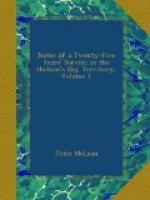The rugged and precipitous banks of George’s River are occasionally surmounted by hills; at the base of all these elevations, deep horizontal indentures appear running in parallel lines opposite each other on either side of the river,—a circumstance which indicates the action of tides and waves at a time when the other parts of the land were submerged, and the tops of those hills formed islands. Along certain parts of the coast of Labrador rows of boulders are perceived lying in horizontal lines; the lowest about two hundred yards distant from high-water mark, while the farthest extend to near the crest of the adjacent hills. Several deep cavities and embankments of sand are observed in the interior, bearing unequivocal marks of having been, at one time, subject to the influence of the sea.
I shall conclude these few remarks by observing that, whatever conclusions the geologist may arrive at as to the remote or recent elevation of this country, the tops of the higher hills appear to have been formerly islands in the sea; and I doubt not but the same may be said of the higher lands on every part of the Arctic regions. Admitting this to have been the case, it contributes to confirm the theory of that distinguished philosopher, Sir Charles Lyell, as to the cause of the changes that have taken place in the climate of the northern regions.
CHAPTER IX.
THE NASCOPIES—THEIR RELIGION—MANNERS AND CUSTOMS—CLOTHING—MARRIAGE—COMMUNITY OF GOODS.
The Indians inhabiting the interior of Ungava, or, it may be said with equal propriety, the interior of Labrador, are a tribe of the Cree nation designated Nascopies, and numbering about one hundred men able to bear arms. Their language, a dialect of the Cree or Cristeneau, exhibits a considerable mixture of Sauteux words, with a few peculiar to themselves. The Nascopies have the same religious belief as their kindred tribes in every other part of the continent. They believe in the existence of a Supreme Being, the Ruler of the universe, and the Author of all good. They believe, also, in the existence of a bad spirit, the author of all evil. Each is believed to be served by a number of subordinate spirits. Sacrifices are offered to each; to the good, by way of supplication and gratitude; to the evil, by way of conciliation and deprecation. Their local genii are also supposed to be possessed of the power of doing good, or inflicting evil, and are likewise propitiated by sacrifices; the “men of medicine” are viewed in nearly the same light. A few of them who visit the king’s posts, have been baptized, and taught to mutter something they call prayers, and on this account are esteemed good Christians by their tutors; while every action of their lives proves them to be as much Pagans as ever; at least, to those who look for some fruit of faith, and who may be ignorant of the miraculous efficacy of holy water, and can form no idea of its operation on the soul, they appear so.




